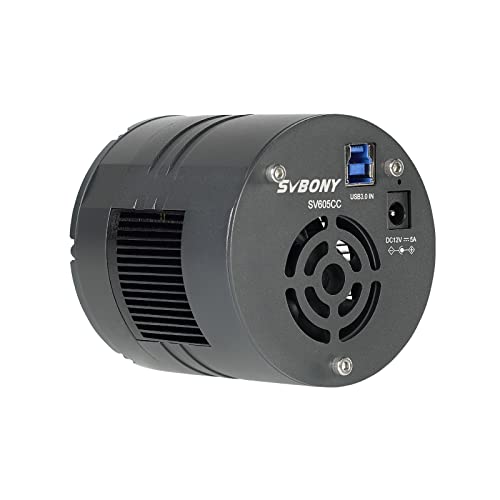If you want reliable deep sky imaging, I recommend the SVBONY SV605CC for its high resolution, good cooling stability, and compatibility with multiple systems. The Astromania SGCMOS series offers auto-guiding and solid build quality, making it a strong choice for capturing faint objects. Both cameras have their pros and cons, but if you keep exploring, you’ll find key details that can help you pick the perfect setup for your astrophotography needs.
Key Takeaways
- The SVBONY SV605CC offers high resolution, efficient cooling, and broad OS compatibility, making it ideal for budget-conscious deep sky imaging.
- Astromania SGCMOS series supports auto-guiding and long exposures but may face driver issues on Windows 11, impacting stability.
- Both cameras feature TEC cooling systems that reduce sensor noise during long exposures, essential for deep sky astrophotography.
- Consider sensor sensitivity, resolution, and control options when choosing between these cameras for optimal image quality.
- Compatibility with popular astrophotography software and stable drivers are crucial for successful deep sky imaging with cooled CMOS cameras.
SVBONY SV605CC Cooled Camera, 9MP CMOS Telescope Camera
If you’re looking for an affordable cooled CMOS camera capable of deep sky imaging, the SVBONY SV605CC is an excellent choice. It features a 9MP IMX533 sensor with 3008×3008 resolution and 80% quantum efficiency, boosting shooting efficiency. The camera can cool the sensor to 30°C below ambient, ensuring stable images. Compatible with Windows, Mac, Linux, and more, it offers flexible control via Wi-Fi, USB, or remote. Its compact, lightweight design makes it suitable for various setups. While it has some noise and cooling stability issues, many users find it a great budget option for capturing nebulae, galaxies, and planetary details.
Best For: amateur astronomers and hobbyists seeking an affordable, versatile cooled camera for deep sky astrophotography and planetary imaging.
Pros:
- Budget-friendly option with good image quality for its class
- Compatible with multiple operating systems and control options (Wi-Fi, USB, remote)
- Compact and lightweight, suitable for various setups and portable use
Cons:
- Inconsistent cooling performance and potential stability issues
- Noisy fan may affect outdoor use and longevity
- Higher noise levels and occasional frame drops can impact image quality and calibration results
Astromania SGCMOS Series Telescope CMOS Camera
The Astromania SGCMOS Series Telescope CMOS Camera stands out as an excellent choice for amateur astronomers who want reliable auto-guiding and multicolor imaging capabilities. It features a high-sensitivity sensor with fast frame rates and long exposure support, ideal for capturing deep-sky objects. The aluminum CNC housing ensures durability, and the 1.25-inch nosepiece allows precise focusing and filter installation. With a built-in ST4 auto guider port and compatibility with Linux, Windows, and Mac (though limited), it offers versatile integration. While some driver issues exist, especially on Windows 11, many users appreciate its guiding performance and affordable price, making it a solid option for astrophotographers.
Best For: Amateur astronomers seeking affordable, reliable auto-guiding and multicolor imaging capabilities for astrophotography and deep-sky observation.
Pros:
- Supports long exposure astrophotography and auto-guiding with high sensitivity sensor
- Durable aluminum CNC housing with standard 1.25-inch interface for easy focusing and filtering
- Compatible with Linux, Windows (though limited on Windows 11), and Mac (with caveats) for versatile use
Cons:
- Driver issues, especially on Windows 11, may require workarounds or updated drivers
- Lower sensitivity compared to premium brands like QHY or ZWO, necessitating longer exposures
- Limited lens options unless spacers are used due to C-mount design and sensor housing constraints
Factors to Consider When Choosing Cooled CMOS Astro Cameras for Deep Sky Imaging

When selecting a cooled CMOS astro camera, I focus on factors like cooling efficiency, sensor quality, and compatibility with my equipment. These elements directly impact image clarity, noise levels, and overall performance. Understanding these points helps me choose the right camera for deep sky imaging success.
Cooling Efficiency and Stability
Achieving superior cooling efficiency and stability is vital for high-quality deep sky imaging with CMOS astro cameras. Effective cooling, usually via TEC systems, can lower sensor temperatures by 20°C to 40°C below ambient, notably reducing thermal noise. However, cooling stability is just as important; it depends on the camera’s ability to maintain consistent sensor temperatures during long exposures. Fluctuations can lead to increased noise and inconsistent images, especially if the TEC or cooling circuitry isn’t rated properly. Proper thermal management—such as good insulation and heat dissipation—prevents temperature drift caused by environmental changes. Reliable cooling stability ensures reduced dark current, consistent calibration frames, and an improved signal-to-noise ratio, all essential for capturing clear, detailed deep sky images.
Sensor Quality and Resolution
Choosing the right cooled CMOS astro camera hinges largely on sensor quality and resolution, which directly affect image detail and overall performance. High-quality sensors offer around 80% quantum efficiency, maximizing light capture in low-light conditions—crucial for deep sky imaging. Sensor resolution, measured in megapixels and pixel size, determines how much detail your images can reveal; smaller pixels, like 3.76μm, provide finer resolution but may require longer exposures. Sensor size also matters, ranging from 1/2 inch to full-frame, influencing field of view and the capacity to capture wide or detailed images. Cooled sensors reduce thermal noise, enabling clearer long exposures, while a broader dynamic range allows you to record both faint and bright features simultaneously. All these factors combine to impact your astrophotography results considerably.
Compatibility With Equipment
Selecting a cooled CMOS astro camera that seamlessly integrates with your existing equipment requires careful attention to compatibility factors. First, verify the camera’s interfaces, like USB 3.0, USB 2.0, or C-mount, match your setup. Next, confirm it supports your operating system—whether Windows, Linux, or Mac—to avoid software issues. Compatibility with your telescope’s focuser and mounting system is also vital; check for compatible adapters and sensor sizes. If guiding is part of your setup, confirm the camera supports standard auto-guiding ports like ST4 or offers remote control options via Wi-Fi or Ethernet. Finally, review the software drivers and SDK support to guarantee smooth operation with your preferred astrophotography or image processing software, making integration straightforward and hassle-free.
Noise and Image Clarity
When evaluating cooled CMOS astro cameras for deep sky imaging, understanding noise and image clarity is essential. Higher noise levels often stem from inadequate cooling, which increases thermal noise and reduces image quality. Dark frames can show horizontal lines or banding artifacts, making calibration necessary to maintain clarity. The sensor’s quantum efficiency directly affects the signal-to-noise ratio; higher QE results in clearer images in low-light conditions. Inconsistent cooling performance or frame drops can cause variability in noise levels, impacting sharpness and detail. Fortunately, post-processing techniques like stacking and noise reduction algorithms can notably improve image clarity, even when noise is present. Choosing a camera with stable cooling and high QE helps ensure that your astrophotos are sharp, detailed, and true to the deep sky objects you’re capturing.
Software and Control Options
Understanding noise levels and image clarity is essential, but equally important is how you regulate and operate your cooled CMOS astro camera. I look for cameras that support multiple control interfaces like USB, Wi-Fi, or remote control, offering flexibility during setup. Compatibility with astrophotography software such as SharpCap, ASCOM, INDI, and PHD2 ensures smooth image acquisition and guiding. I also prioritize cameras with reliable drivers and regular software updates, especially for Windows 10, 11, or Mac OS, to maintain stability. Some models include dedicated software with features like live stacking, dark frame correction, and manual focus adjustments, which enhance my control over imaging sessions. Finally, I consider user reviews and manufacturer support, as they indicate ease of use and long-term reliability for both beginners and advanced astrophotographers.
Frequently Asked Questions
How Does Cooling Impact Image Noise in CMOS Astro Cameras?
Cooling markedly reduces image noise in CMOS astro cameras by lowering the sensor’s temperature, which minimizes thermal noise or dark current. When the sensor gets cooler, it produces fewer false signals, resulting in cleaner, more detailed images of deep sky objects. I find that investing in good cooling systems helps me capture sharper, more accurate astrophotos, especially during long exposures where noise can easily ruin image quality.
What Is the Typical Lifespan of Cooled CMOS Sensors?
The typical lifespan of cooled CMOS sensors is around 5 to 10 years, but that can vary depending on usage and maintenance. I’ve found that proper handling, avoiding excessive heat, and regular cleaning help prolong their life. Cooling reduces noise and wear, but over time, sensors can still degrade. Staying vigilant for signs of sensor deterioration ensures I get the most out of my astro imaging gear.
Are Cooled CMOS Cameras Compatible With All Telescope Mounts?
Cooled CMOS cameras are generally compatible with most telescope mounts, but you should check the specific connection types and software compatibility. I always make certain my camera’s mounting interface matches my mount’s port, and I verify that the control software works with my equipment. While many modern cameras are versatile, some older mounts might need adapters or additional software updates for seamless operation.
How Do Software Calibration Processes Differ for Cooled vs. Uncooled Cameras?
Think of calibration like tuning a musical instrument; the process differs for cooled versus uncooled cameras. With cooled cameras, I use more precise dark frames because their lower temperatures reduce noise, making calibration more effective. Uncooled cameras need more extensive calibration due to higher thermal noise, requiring additional flats and darks. This careful tuning guarantees I get the clearest, most accurate images of the deep sky.
What Are the Maintenance Requirements for Cooled CMOS Astro Cameras?
Cooled CMOS astro cameras require regular maintenance to keep them performing at their best. I always make certain to keep the sensor and cooling system clean, avoiding dust buildup that can affect image quality. I also check the seals and cooling connections for any leaks or damage. Periodically, I update the firmware and calibrate the camera to guarantee consistent results. Proper handling and gentle cleaning are key to longevity.
Conclusion
Choosing the right cooled CMOS astro camera is like selecting a trusted compass for your celestial journey. It guides your eyes through the darkness, revealing hidden wonders with clarity and stability. Whether you prefer the precision of the SVBONY SV605CC or the versatility of the Astromania SGCMOS, remember that your camera is the telescope’s heartbeat. With the right choice, the universe’s secrets become your own, illuminating your passion for deep sky imaging.













